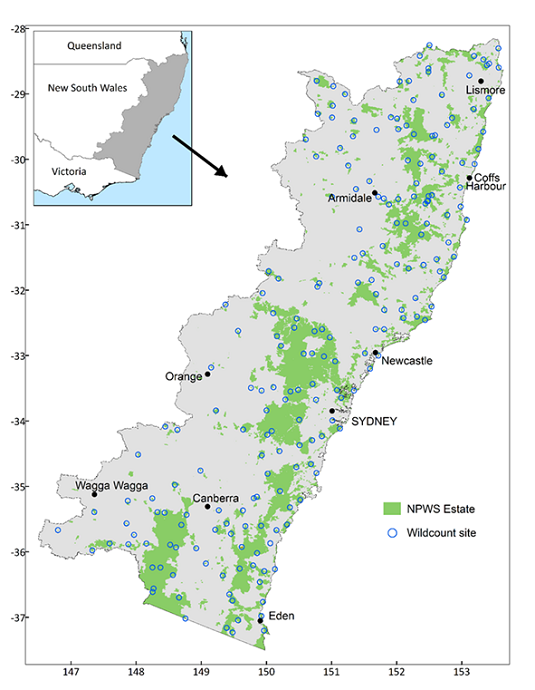WildCount was established in response to a State of the Catchments 2010: native fauna report, which identified data gaps for a range of vertebrate species in New South Wales. The report found that we did not have enough information to assess broadscale trends in even our most common species.
WildCount examined trends in the occurrence of animals and was one of the first monitoring programs in the world to assess a broad suite of animals at such a large scale. The data generated identified changes in occupancy to understand if animals are in decline, increasing or stable and ultimately guide on-ground management.
The videos below have more information about the program.
WildCount provides a statewide framework for vertebrate fauna monitoring in the reserve system.
Watch our 2014 update, after 3 seasons of WildCount.
Where WildCount monitored wildlife
The 200 WildCount camera sites are located in 146 national parks and reserves across eastern New South Wales. Every year, between 2012 and 2021, 4 motion-sensing cameras were placed at each site between February and June. Cameras were left in the field for a minimum of 2 weeks and captured over 250,000 images each year.

Figure 1: Map showing the location of 200 WildCount sites across 146 national parks and reserves in eastern New South Wales
What did we do with all the photos?
A small team of researchers processed and reviewed every image, identifying the species captured at each WildCount site. Species lists were distributed to local National Parks and Wildlife Service staff annually.
Occupancy is a measure of the proportion of sites where each species was recorded. Ecologists analysed the data to determine species occupancy over time. The findings from the first 5 years of WildCount (2012 to 2016) have been published in a mid-term report. The 10-year report is expected to be published in mid-2023.
In the first 5 years, WildCount ecologists:
- recorded 157 species/taxa
- analysed 39 species for changes in occupancy
- found 7 of the 39 showed evidence of change (either an increase or a decrease) at the 200 survey sites
- determined that WildCount can likely monitor changes in occupancy for at least 10 species over 10 years (see Table 1).
WildCount results reinforce the importance of broadscale, long-term monitoring programs to understanding our wildlife.
The WildCount 10-year report is in the final stages of preparation and is expected to be published in mid-2023.
Table 1: Preliminary analysis of species that can be monitored for changes in occupancy over 10 years
| Species | Average number of site species present each year | Trend from 2012–16 |
|---|---|---|
| Swamp wallaby | 169 | Stable |
| Common brushtail possum | 111 | Stable |
| Red fox | 79 | Stable |
| Superb lyrebird | 73 | Stable |
| Bare-nosed wombat | 70 | Stable |
| Eastern grey kangaroo | 65 | Stable |
| Red-necked wallaby | 59 | Stable |
| Short-beaked echidna | 51 | Stable |
| Grey shrike-thrush | 50 | Stable |
| Long-nosed bandicoot | 48 | Declining |
Note: This list is based on analysis of species detections at sites in the first 5 years of surveys (2012 to 2016).
How the data helps New South Wales
WildCount's primary aim was to detect change in target wildlife populations to inform conservation efforts, including listing on the IUCN (International Union for Conservation of Nature) Red List of species vulnerable to extinction for those species that declined by 30% or more.
Datasets from long-term monitoring programs such as WildCount also have substantial value for detecting relationships between changes in animal populations and the impacts of factors such as climate patterns, seasonal weather and environmental events. For example, WildCount provides an extensive dataset from 200 sites before the catastrophic 2019–20 bushfires. Nearly 70 WildCount sites were burned in 2019–20, and information captured at those sites may assist in understanding the impacts of bushfires on our native animals and how wildlife recovers.
WildCount's broadscale monitoring methods have also led to some exciting and useful species detections, including new records of threatened species and tracking of pest species incursions. This information guides management decisions and enhances programs. For example, the discovery of parma wallabies outside their known range led to increased targeted surveys in northern NSW, and the first koala records for some reserves were detected with WildCount cameras.
Records of animals captured by WildCount cameras are submitted to the NSW BioNet, making the data freely available to anyone with an interest. As of July 2020, 35% of publicly available mammal records on BioNet were from WildCount.
Citizen science in action
From 2014 to 2020, WildCount was reliant on the dedication and support of volunteers. Each of the 6 field teams was made up of one National Parks and Wildlife Service officer and a volunteer operating across New South Wales from February to late May. Volunteers typically dedicated one full week to the program.
Meet National Parks and Wildlife Service volunteer Vicky as she recounts her experiences during the 2018 WildCount season.
NPWS volunteer Vicky Calleja recounts her experiences during a week of camera deployment and collection during the 2018 WildCount season.
Table 2: Contribution of volunteers to WildCount
| Year | Number of volunteers | Total volunteer hours |
|---|---|---|
| 2014 | 35 | 1,465 |
| 2015 | 58 | 1,972 |
| 2016 | 55 | 2,230 |
| 2017 | 52 | 1,945 |
| 2018 | 46 | 1,755 |
| 2019 | 43 | 1,324 |
| 2020* | 22 | 518 |
*Prior to a COVID-19 enforced shut-down
How to volunteer
If you are interested in volunteering with the National Parks and Wildlife Service, a wealth of amazing opportunities are available on the Volunteer Portal.
Photo albums
Over 1.9 million animal images have been captured as part of the WildCount program. A selection of these are available on Flickr.